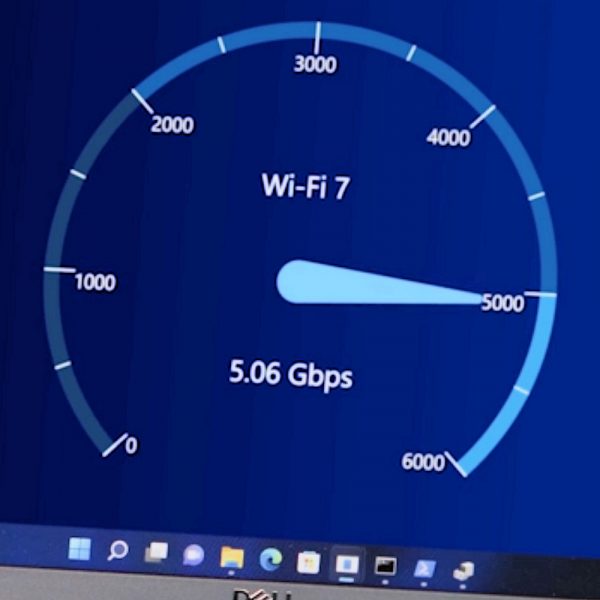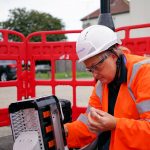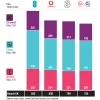Broadcom and Intel Push Real-World WiFi 7 Speed Test to 5Gbps

Chip and technology giants Intel and Broadcom have achieved an important milestone this week after they demonstrated the first cross-vendor Wireless Local Area Network (WLAN) network link using prototypes of their next generation Wi-Fi 7 (802.11be) hardware, which achieved data speeds of over 5Gbps (Gigabits per second).
At present most UK consumers have yet to even adopt kit that supports the current Wi-Fi 6 (802.11ax) standard, which is to say nothing of the 6GHz supporting Wi-Fi 6E (adds support for the 6GHz band) or Wi-Fi 6 Release 2 (some additional enhancements) standards that are even further behind in the adoption cycle. But that hasn’t stopped the development of future Wi-Fi 7 (802.11be – Extremely High Throughput) technology (example).
In theory, the new standard might be able to achieve a theoretical peak data speed of around 40-46Gbps (Gigabits per second), but history tells us that our real-world experiences will probably still fall considerably below that level – due to factors like distance, signal obstructions, power levels, spectrum allocations, antenna design and interference from other networks.
Advertisement
As such, it’s interesting to note the recent hardware demo from Intel and Broadcom, which are two major players in this sector. The “trial” used an Intel® Core™ processor-based laptop from Dell with a Wi-Fi 7 adapter, which was then connected to a Broadcom Wi-Fi 7 based access point – both prototypes using an early draft of the standard.
The good news is that this trial was able to achieve a speed of over 5Gbps, which is perhaps a reasonable real-world expectation of what Wi-Fi 7 will actually hit in ideal circumstances (forget about the aforementioned theoretically peaks, they’re fantasy). Naturally, we don’t know much about the test setup being used, but we suspect that the laptop and access point were both sitting in very close proximity.
All of this is important because, if you’re familiar with the latest Wi-Fi 7 draft, then the speed they achieved is roughly in keeping with some real-world models of what the technology might actually deliver. Generally, to hit 5Gbps+, you’d need a 2×2 device that can harness the full 320MHz channels, 4096 QAM and Multi-Link Operation capabilities. A potential real-world peak here could be around 5.7Gbps to 5.8Gbps.
The IEEE doesn’t currently expect to have a completed and fully approved Wi-Fi 7 standard ready until around early 2024, although it’s fairly common to see early products launch before then, albeit using a near-final draft of a new standard (expect to pay through the nose for that). The irony is that this means some people might just get their hands on Wi-Fi 7 kit before the latest release of Wi-Fi 6 has been adopted.
Advertisement
Key Wi-Fi 7 Advancements
➤ Multi-Link Operation (MLO) that enables devices to both simultaneously transmit and receive across different bands (2.4GHz, 5GHz and 6GHz) and channels. Wi-Fi 6 could already harness several links simultaneously, but these links are usually independent, and MLO seeks to change that in order to make efficient use of the channel resources.
➤ Channel size of up to 320MHz (up from 160MHz with Wi-Fi 6)
➤ Support for 4096-QAM (Quadrature amplitude modulation) OFDMA (up from 1024-QAM)
➤ Support for 16×16 Multi-User, Multiple-input, Multiple-output (MU-MIMO) technology (up from 8xX UL/DL MU-MIMO).
NOTE: Wi-Fi 7 could also enable the use of additional spectrum bands between the 1Ghz and 7GHz+ range, but that may depend upon availability (regulation).
Mark is a professional technology writer, IT consultant and computer engineer from Dorset (England), he also founded ISPreview in 1999 and enjoys analysing the latest telecoms and broadband developments. Find me on X (Twitter), Mastodon, Facebook, BlueSky, Threads.net and Linkedin.
« ISP Community Fibre Expand London FTTP Rollout to Harrow
Open Fibre Networks Ltd ISP Boosts UK FTTP Plans to 900Mbps »























































Exciting to see. As you say, real world speeds are never as good as the theoretical maximums. Nonetheless, every generation of WiFi has pushed up the real world speeds.
Hopefully there’s less of a delay in getting WiFi 7 finalised, then shipped on actual devices. WiFi 6 was quite a saga.
They always talk about achieving unbelievable throughput speeds but they never-ever mention ping, which I think is way more important for these gurus to concentrate on with these new technologies
To be fair, every WiFi standard has made changes to improve latency – it’s been a key focus, which is why the latest WiFi 5 and 6 chipsets have so much less of it than those that came before.
My Wi-Fi 6 setup gives me a continuous stable ping of 1ms. What more could you ask for?
Just my thought, I recently bought Aruba AP22 (i know this is not a high end AP) and I got a 1Gbit connections. As I have the laptop less then 20 cm away from AP the maximum speed on WIFI6 i get (Yes it is Wifi6 as laptop and ap both supports this) real life experience 720Mbps when i run speed test. Most of the time its is 400-500.
I was also on the call with Aruba support and they said max expectancy is 60% of theoretical max speed.
For me what they are saying in the video is that, we have improved so the increased speed is noticeable yet it won’t be life changing. Huge improvement, and i can see that.
@Essa As the Aruba AP22 is a very low end device it only supports a 80mhz channel when it comes to WiFi 6, therefore to get the best speed I would suggest you look for something that supports 160mhz channel width.
Typically your actual speed with be around half of what the “connection speed” is showing.
Thank you for the kind feedback. Before investing in Aruba AP22 I did know that it was a low end device, however it has been enlighten to know that what I should have aimed for is a AP with 160hz support.
320MHz channel wide 🙂 Good luck in getting more than 1Gbps in real environment like homes built 5m to each other each having WiFi6 or 7 with Mesh and 30+ devices connected. It is the same bullshit we’ve been fed with 3G, 4G and 5G latency and network speed.
You know what they say, spend less on devices and more on larger plot of land to have house on.
Considering 1Gbps is becoming the top package for a lot of areas I think this would ok for now.
320mhz, yes please.
I’d happily adopt 6E… But I have yet to see an access point supporting 6GHz arrive in the UK. I don’t know if that’s because everyone is still hoping that the UK might release more spectrum than they originally committed to, or what the hold up is.
Really??? The NETGEAR Orbi Quad-band WiFi 6E Mesh System (RBKE963B) has been available on Amazon for months.
Gosh that’s nice. Meanwhile I’m having trouble getting my WIFI6 kit to do 600mbit when the box proudly proclaims it can do 3Gbits.
What device are you testing on? The Intel cards in my laptops won’t do more than 600-700 with their 2×2 configuration. My phone’s however easily do 1gbps+ with 4×4.
I can mac out my 550mbps connection over wifi 5 on an AP that claims 867mbps. The 3gbps speeds they list unfortunately is the sum total of peak speed from all the likely three radios that the AP has.
Still very few devices that support Wi-fi 6 unless people go for high-end devices. Almost every thing that is on Wi-fi in this house is still using 2.4Ghz, most smart home devices still use 2.4 ghz.
Most things don’t need the higher speed, I also found anything running on 5Ghz have worse range than 2.4ghz, so unless they can do something about that, then Wi-fi 6 and 7 is a waste of time here.
When is come Wi-Fi 7. ?
Date. 2022. 09. 20